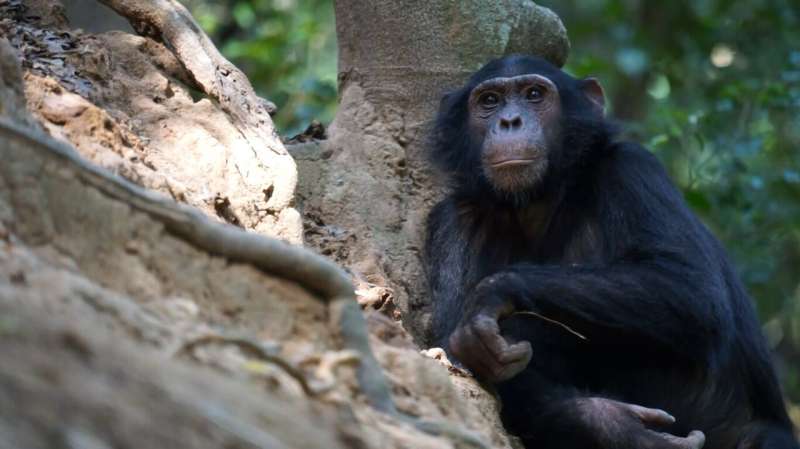
Chimp fishing for termites. Credit: Seth Phillips
The discovery that chimpanzees use tools to fish for termites revolutionized our understanding of their abilities—but we still don’t have crucial context to help us understand termite fishing and chimpanzee minds. Are chimpanzees fishing for a seasonal treat or trying their luck?
Researchers based at the University of California Santa Cruz (UCSC) and University College London (UCL) have investigated the relationship between termite availability and chimpanzee fishing. They found that termites are most available early in the wet season. Although other foods are abundant at that time, chimpanzees choose to termite-fish then.
“I believe these results set up an interesting hypothesis about wild chimpanzee foraging cognition,” said Dr. Vicky Oelze, UCSC, senior author of the study in Frontiers in Ecology and Evolution. “Though we can never read a chimpanzee’s thoughts, we can perhaps start to get an idea of their expectations of resource availability by analyzing the instances in which they arrive at termite mounds and investigate them for fishing viability.”
Termite treats
Termites are a key source of nutrients for chimpanzees—but the species chimpanzees prefer live deep within fortress-like mounds. However, some termites will disperse to start a new colony elsewhere, leaving the mound via flight holes the chimpanzees exploit for termite fishing. In some places, chimpanzees fish all year; in others, fishing is seasonal.
Understanding termite availability is important to understanding the variation in chimpanzee use of fishing tools. Does tool use vary between chimpanzee populations because the opportunities are different, because needs are different, or because tool use is unlikely to be invented or maintained? To understand the predators, we need to understand the prey.
The scientists focused on Issa Valley, Tanzania, which has very distinct wet and dry seasons. The researchers collected years of meteorological data and camera trap footage of 13 mounds to map the dispersals and predation of termites across time. They also carried out termite-fishing trials at 14 mounds between 2018 and 2022, copying chimpanzee tools and techniques.
“When I first visited the Issa Valley, I quickly learned that it was more difficult to termite-fish than I had expected,” said Seth Phillips, UCSC, corresponding author. “It alerted me to the idea that effective foraging for these termite prey might be more complicated than people commonly understand it.”
Chimp sniffing termite mound. Credit: Seth Phillips
Termites on the menu
Of 1,924 attempts at termite fishing, 363 extracted termites. The scientists found that they were much more likely to be able to extract termites as rainfall increased—until 200mm of rain had fallen. Then the proportion of successful trials dropped. Most termite mounds were most active between 50–200mm of cumulative rainfall. Dispersal flights only took place in the wet season and stopped almost completely after 400mm of rainfall.
“We are currently reviewing camera trap footage of the chimpanzee behaviors at these mounds,” said Phillips. “We want to know how chimps adapt their searching behavior according to seasonal changes. For instance, do they investigate termite mounds directly after rainfall after a long dry spell? This data could say something interesting about their foraging cognition as related to tool-use.”
Chimpanzees were among the most frequently recorded predators at termite mounds during dispersal flights and often arrived carrying a tool. At this time of year in Issa Valley, other food is available; the chimpanzees use tools to termite-fish because they can, not because they need to.
Gone fishing
Although some chimpanzee communities exploit termites all year, including at relatively nearby Gombe Stream, termite fishing there also peaks in the early wet season. Some year-round fishers may be benefiting from softer soil or more effective toolsets. It’s unclear whether more sophisticated tools would allow continuous exploitation of termite mounds at Issa Valley, but initial tests suggest otherwise.
“At the end of the day, we are human experimenters attempting to replicate a chimpanzee behavior,” cautioned Phillips. “It should not be taken for granted, for instance, that we are just as effective at foraging for termites with these tools as chimpanzees. I would expect the window of opportunity for chimpanzees to termite-fish in the Issa Valley is at least a little bit wider than it is for human researchers.”
More information:
A chimpanzee’s time to feast: Seasonality of Macrotermes flight hole activity and alate dispersal flights detected by termite-fishing experiments and camera traps in the Issa Valley, Tanzania, Frontiers in Ecology and Evolution (2023). DOI: 10.3389/fevo.2023.1289433
Citation:
‘Fishing’ chimpanzees found to enjoy termites as a seasonal treat (2023, November 17)
retrieved 17 November 2023
from https://phys.org/news/2023-11-fishing-chimpanzees-enjoy-termites-seasonal.html
This document is subject to copyright. Apart from any fair dealing for the purpose of private study or research, no
part may be reproduced without the written permission. The content is provided for information purposes only.
>>> Read full article>>>
Copyright for syndicated content belongs to the linked Source : Phys.org – https://phys.org/news/2023-11-fishing-chimpanzees-enjoy-termites-seasonal.html
